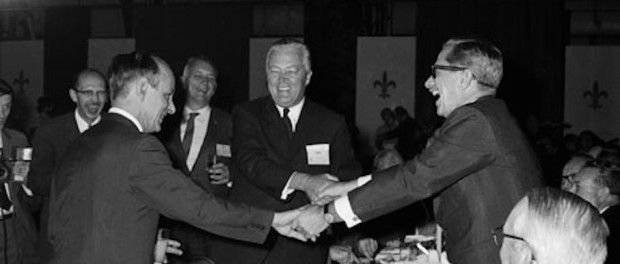1957: Québec’s Natural Gas Company & Other Quebec Curios
Part of “Shadows and Revolution”, 1900-1960
 René Lévesque, Jean Lesage, and Daniel Johnson Sr. during the inauguration of the Manic-5 hydroelectric dam, 1968. Source: Musée Virtuel/Hydro-Québec.
René Lévesque, Jean Lesage, and Daniel Johnson Sr. during the inauguration of the Manic-5 hydroelectric dam, 1968. Source: Musée Virtuel/Hydro-Québec.
Natural gas, a fossil fuel substance that occurs naturally in the soil, can be harnessed to power homes and vehicles and is generally less toxic to the environment than other fossil fuels in the same category such as gasoline. Its pitfall is that it is a non-renewable source of energy. This pitfall, however, was not of a concern in 1957. The question concerning natural gas was whether or not to keep natural gas in the public sector.
One of Adélard Godbout’s side projects in the 1940s was the nationalisation of hydroelectricity by the acquisition of Montreal Light, Heat and Power. Its side effect was not only bringing hydroelectricity into the public sector, by acquiring Montreal Light, Heat and Power, it also acquired a system that was able to distribute natural gas throughout Montréal. Hydro-Québec sat on its natural gas acquisition until the end of the 1940s, when Alberta and Ontario wanted to create a pipeline and offered Hydro-Québec the chance to extend this pipeline to connect to Montréal’s natural gas systems. A Commission responsible to recommend a decision decided against this collaboration and instead recommended that Hydro-Québec sell off its natural gas to form a private company. This company, created on April 25, 1957, was called the Corporation du gaz naturel du Québec.
In distributing natural gas, the new company had to be careful: in its original state, natural gas does not have an odour and if it is allowed to accumulate in a closed space such as a house, inhaling it in large amounts can lead to death. In order to be able to detect it, the Corporation du gaz naturel had to add a chemical called Mercaptan, a sulphuric compound that smells like rotten eggs, to the gas. The addition of this compound would make the gas easier to detect and for people to know to evacuate a building before it builds up to dangerous amounts.
The Corporation du gaz naturel’s major development was the transport of natural gas through underground pipelines to remote areas. Beginning in 1958, pipelines transported natural gas from the United States all the way to Québec, and soon pipelines were able to transport this new source of energy to the South Shore and the Sorel-Tracy area. Major work for the Corporation du gaz naturel du Québec came in the 1960s, with Expo 67, whose energy of choice was Québec’s natural gas. In 1969, it changed its name to something familiar to many generations of Quebeckers: it renamed itself Gaz Métropolitain, or Gaz Métro to us common folk.
Pipeline work continues to move on to even further regions, with its most current project intended to extend the pipelines all the way to the Bellechasse region of Québec, almost three hundred kilometres from Montréal. Earlier last year, Gaz Métro rebranded itself as Énergir. Don’t forget to pay your bill.





